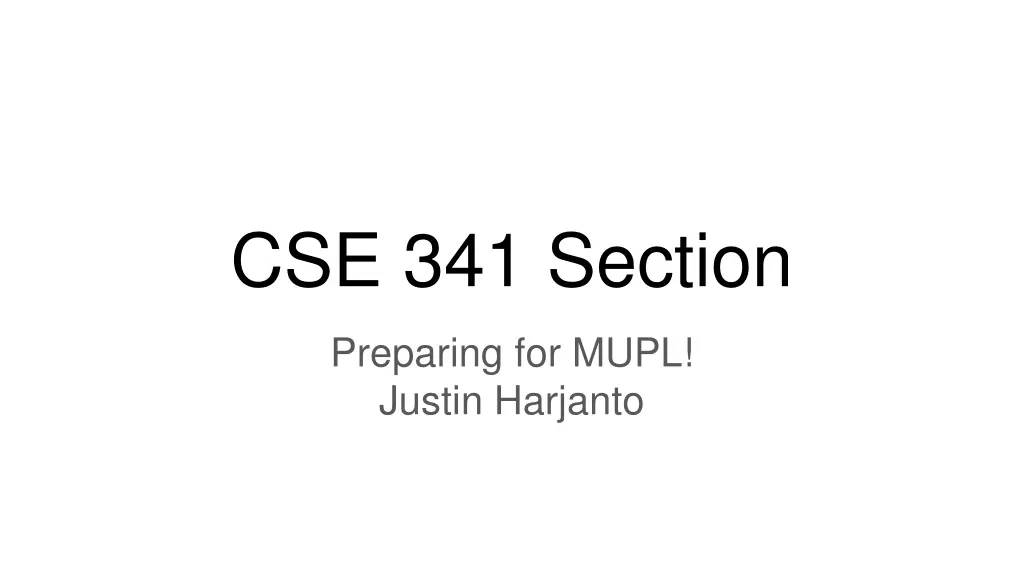
Building a MUPL Interpreter with Justin Harjanto
Join Justin Harjanto in preparing for MUPL by building an interpreter to evaluate AST nodes represented as Racket structs. Learn about checking syntax, evaluating semantics, and handling AST evaluation in this comprehensive guide.
Download Presentation

Please find below an Image/Link to download the presentation.
The content on the website is provided AS IS for your information and personal use only. It may not be sold, licensed, or shared on other websites without obtaining consent from the author. If you encounter any issues during the download, it is possible that the publisher has removed the file from their server.
You are allowed to download the files provided on this website for personal or commercial use, subject to the condition that they are used lawfully. All files are the property of their respective owners.
The content on the website is provided AS IS for your information and personal use only. It may not be sold, licensed, or shared on other websites without obtaining consent from the author.
E N D
Presentation Transcript
CSE 341 Section Preparing for MUPL! Justin Harjanto
Todays Agenda Building a MUPL Interpreter Assume Correct Syntax Check for Correct Semantics Evaluating the AST MUPL Macros Eval, Quote, and Quasiquote 2
Building a MUPL Interpreter Skipping the parsing phase Do Not Implement Interpreter written in Racket Racket is the Metalanguage MUPL code represented as an AST AST nodes represented as Racket structs Can assume AST has valid syntax Can NOT assume AST has valid semantics 3
Correct Syntax Examples Given this syntax: (struct int (num) #:transparent) (struct add (e1 e2) #:transparent) (struct ifnz (e1 e2 e3) #:transparent) We can need to evaluate these MUPL programs: (int 34) (add (int 34) (int 30)) (ifnz (add (int 5) (int 7)) (int 12) (int 1)) 4
Incorrect Syntax Examples Given this syntax: (struct int (num) #:transparent) (struct add (e1 e2) #:transparent) (struct ifnz (e1 e2 e3) #:transparent) We can assume we won t see MUPL programs like: (int dan then dog ) (int (ifnz (int 0) (int 5) (int 7))) (add (int 8) #t) (add 5 4) Illegal input ASTs may crash the interpreter - this is OK 5
Check for Correct Semantics What if the program is a legal AST, but evaluation of it tries to use the wrong kind of value? For example, add an integer and a function You should detect this and give an error message that is not in terms of the interpreter implementation We need to check that the type of a recursive result is what we expect No need to check if any type is acceptable 6
Evaluating the AST eval-exp should return a MUPL value MUPL values all evaluate to themselves Otherwise we haven t interpreted far enough (int 7) ; evaluates to (int 7) (add (int 3) (int 4)) ; evaluates to (int 7) 7
Macros Review Extend language syntax (allow new constructs) Written in terms of existing syntax Expanded before language is actually interpreted or compiled 8
MUPL Macros Interpreting MUPL using Racket as the metalanguage MUPL is represented as Racket structs In Racket, these are just data types Why not write a Racket function that returns MUPL ASTs? 9
MUPL Macros If our MUPL Macro is a Racket function (define (++ exp) (add (int 1) exp)) Then the MUPL code (++ (int 7)) Expands to (add (int 1) (int 7)) 10
quote Syntactically, Racket statements can be thought of as lists of tokens (+ 3 4) is a plus sign , a 3 , and a 4 quote-ing a parenthesized expression produces a list of tokens 11
quote Examples (+ 3 4) ; 7 (quote (+ 3 4)) ; '(+ 3 4) (quote (+ 3 #t)) ; '(+ 3 #t) (+ 3 #t) ; Error You may also see the single quote character used as syntactic sugar 12
quasiquote Inserts evaluated tokens into a quote Convenient for generating dynamic token lists Use unquote to escape a quasiquote back to evaluated Racket code A quasiquote and quote are equivalent unless we use an unquote operation 13
quasiquote Examples (quasiquote (+ 3 (unquote(+ 2 2)))) ; '(+ 3 4) (quasiquote (string-append "I love CSE" (number->string (unquote (+ 3 338))))) ; '(string-append "I love CSE" (number->string 341)) You may also see the backtick ` character used as syntactic sugar for quasiquote The comma character , is used as syntactic sugar for unquote 14
Self Interpretation Many languages provide an eval function or something similar Performs interpretation or compilation at runtime Needs full language implementation during runtime It's useful, but there's usually a better way Makes analysis, debugging difficult 15
eval Racket's eval operates on lists of tokens Like those generated from quote and quasiquote Treat the input data as a program and evaluate it 16
eval examples (define quoted (quote (+ 3 4))) (eval quoted) ; 7 (define bad-quoted (quote (+ 3 #t))) (eval bad-quoted) ; Error (define qquoted (quasiquote (+ 3 (unquote(+ 2 2))))) (eval qquoted) ; 7 (define big-qquoted (quasiquote (string-append "I love CSE" (number->string (unquote (+ 3 338)))))) (eval big-qquoted) ; I love CSE341 17
RackUnit Unit testing is built into the standard library http://docs.racket-lang.org/rackunit/ Built in test functions to make testing your code easier Test for equality, check-eq? Test for True, check-true Test for raised exception, check-exn and many more 18
